|
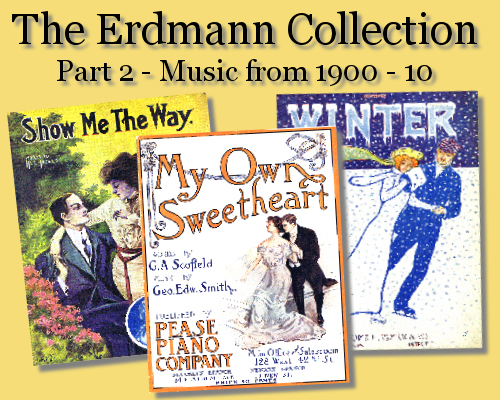
Above: 1900's covers from the Erdmann Collection.
Music of the 1900 - 10 Decade
From the Erdmann Collection
This year we received a generous and most important donation of sheet music from the Erdmann family of New Jersey. This unique donation included sheet music from the late 19th century up to the 1970's. The total number of sheets donated to us exceeded 6,000 and has increased our collection to a level exceeding all but a few library collections and places us as the top private non-profit web library collection in the country. This issue is the second in a series such as we have done with other large collections such as the Marshall-Morrow collection donated to us in 2009. To continue the review of the decades represented by this collection, this issue will look at music from the 1900 - 10 decade in America from the collection. We hope to make much more of our collection available to view through a redesign of our site and help from volunteers to catalog everything, scan and organize the music to make it more accessible.
As in the previous recent articles, we are continuing to include the full cover art in the Scorch versions so you can enjoy them in more detail than our thumbnail images allow. As a result, the Scorch files are much larger than usual so expect some delay in downloading. In most cases, the download file size exceeds 2mb so some will take quite some time depending on your type connection. The wait will be worth it! In addition, all music featured this month is printable using the Sibelius Scorch player.
The decade of the 1900's was seminal in the development of America's popular music. After the explosive change in America's popular music that occurred in the 1890's, the 1900's brought more change and the development of what was becoming a very American style of music. By now, the old 1880's European style music was virtually gone from America's piano bench, replaced by a gayer, positive and optimistic outlook on life as reflected in our music. Of course, the idea of the "Tear Jerker" would stay with us forever, our music was mostly focused on the more enjoyable aspects of life and love.
This issue presents you with many songs that are much less known than many from the period, but representative of the continuing development in American popular music that the first decade of the twentieth century represented. As such, you'll experience a mix of forward looking songs as well as the joy of discovery of some songs that have been long forgotten over the last 111 years. Also this month, all of the featured songs are printable through the use of the Sibelius Software "Scorch" player.
To enjoy the full musical experience, we
recommend that you get the Scorch plug in from our friends at Sibelius software.
The Scorch player allows you to not only listen to the music but to view the
sheet music as the music plays and see the lyrics as well. Each month we also
allow printing of some of the sheet music featured so for those of you who play
the piano (or other instruments) you'll be able to play the music yourself.
It's a complete musical experience! Get the Sibelius
Scorch player now. 
Richard A. Reublin, February, 2011. This article published
November, 2011 and is Copyright © 2011 by Richard A. Reublin and The Parlor
Songs Association, Inc. Text, images or music may not be reproduced in part
or in total without express written permission of the author or a company officer.
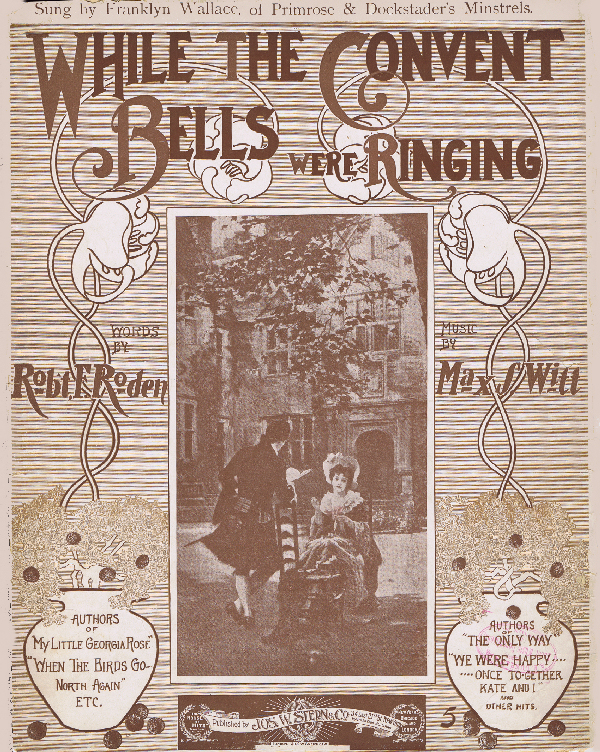 While the Convent Bells Were Ringing While the Convent Bells Were Ringing
1901
Music by: Max Witt
Words by: Robert F. Roden
Cover art: not attributed
During the early 20th century, these was a seeming affection and interest in the sounds and effects of chimes, church bells and carillons. This interest and the resulting musical fad can be further explored through our June, 2002 feature about this style of music. The fad began in these first few years of the century and continued to develop into the 19 teens when it suddenly and perhaps thankfully passed away. Much of the fad centered around trying to mimic the sound of chimes on the piano. Certain chords and intervals used in these songs actually very effectively mimicked the sound.
In this case, the composer sparingly used such mimicry and added a number of short ornamental passages that suggested the sound of bells or chimes. Otherwise, the song is a fairly straightforward romantic ballad that tells the story of a young woman who was "taking the veil," and a young man's love for her and he and her father's desire that she not become a nun. The song has a pleasant introduction and melodies in the verses and chorus. Though it has fallen into obscurity, I think it should be often heard again so I'm delighted to bring it back to life more than a century after first publication.
Both Max Witt and Robert F. Roden (? - 1934) are somewhat lost in time. Though I've been able to find virtually no biographical information on them, I have found a number of songs and/or writings by them. In Roden's case, we know that he was primarily a film writer having written the story or adaptation to several silent era films including Little Miss Nobody (1917), Greater Than Love (story) and Suspicious Wives (1921). His most popular song (lyrics) is probably the 1908 song When It's Moonlight On The Prairie.
Hear this lovely song (  Scorch format, be patient, all the Scorch files this month are very large file sizes, this sheet music is printable using the Scorch plug-in) Scorch format, be patient, all the Scorch files this month are very large file sizes, this sheet music is printable using the Scorch plug-in)
Listen to MIDI version
Lyrics
|
 A Miner's Home Sweet Home A Miner's Home Sweet Home
1902
Music by Charles E. Baer
Words by: George W. Thornton
Cover art: un attributed.
We've seen song after song from this period od popular song that speaks of the sadness and darker side of life. Of course we've treated that issue many times over in individual song discussions and in our special feature on "tear jerkers" from October, 2001. Given the proclivity for this style of song as well as Baer's history of writing such songs (see below information on his song Pictures from the Other Side of Life) we could easily expect the song to be one that shows a poor miner in a state of poverty and hopelessness. That is what I expected but was surprised at the way Baer took such a possibility and turned it into a positive.
The song does tell the tale of a miner, if not impoverished at least needy in many ways. However, the song really speaks to the human spirit and how this man, rather than cry out in helpless jealousy for what other's have in life chooses to find happiness in what little he has and the value of home and family. It also exposes how many of us judge others by their position in life related to our own. The melody is very pleasant harmonies and style are still grounded more in the 1890's than the years to come but I found it to be an uplifting and enjoyable song. We should all take a lesson from songs like this. Given the titles and tone of Baer's songs, it is clear that he had moral messages in mind and a caring attitude towards the less fortunate in life as he wrote his songs.
Charles E. Baer (dates unknown) started his songwriting career in the late 19th century. The earliest song by him I've been able to find is his 1896 work, Pictures from the Other Side of Life which he wrote both words and music. That song is a rather lengthy work that speaks to a number of "scenes" in American life far from what we want to see; a gambler who has lost everything, a lonely mother who is forgotten, two brothers one of which became rich and the other destitute and a mother and child, cast off and homeless. Other songs by him include; My Sweet Eileen (1898, lyrics), When the Robin Red-breast, Sings his Home, Sweet Home (1901, lyrics), When the Orioles Come North Again (1906, lyrics) and For the Blue Juniata I Am Longing (1901, lyrics and music).
Hear this coal miner's song of happiness
(  Scorch format, be patient, long load time) Scorch format, be patient, long load time)
listen to MIDI version
Lyrics |
| |
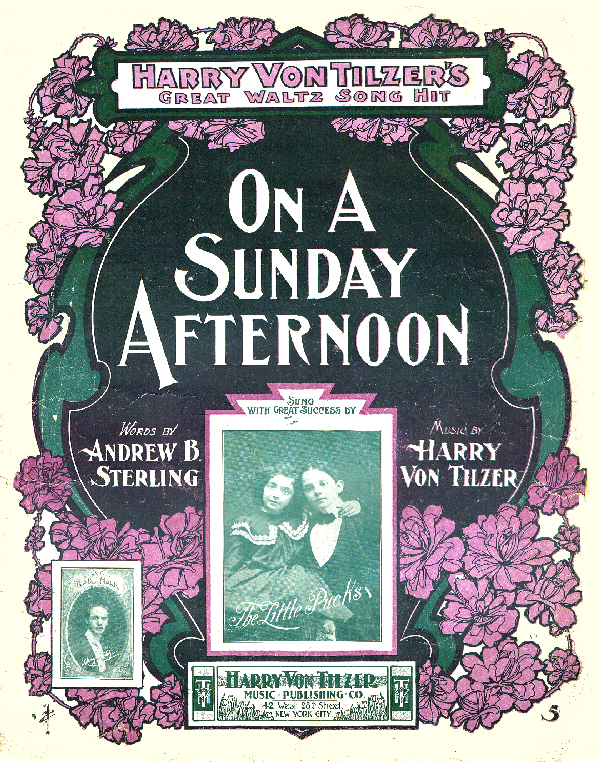 On a Sunday Afternoon On a Sunday Afternoon
1902
Music by: Harry Von Tilzer
Words by Andrew B. Sterling
Cover art: not attributed
Harry Von Tilzer was known as the man who launched a thousand hits and his reputation followed him with every song he published during his long career. We've provided a short biography below for you but if you'd like to learn more about this incredibly productive and popular songwriter, stop by our special biography of Von Tilzer to read more about him and listen to many more of his songs.
Though he began writing songs around 1892, only one was published by 1898 and so this song is actually among some of his earliest works but by now his stardom as a songwriter was on the rise. The cover trumpets his name and says it is his "Great Waltz Song Hit." It is however, in my opinion, one of his best but is a rather simple and straightforward waltz. A bit plodding at times, it does have a nice melody and sentiment in the lyrics that can account for the song's potential success. Of course two of the key elements in making a song a hit include a memorable melody and lyrics that speak to the general public. Who can deny the happiness found on a temperate June day at the park with the one you love?
 Harry
Von Tilzer (b. July 8, 1872, Detroit, MI, d. Jan.
10. 1946, New York, NY nee: Harry Gumm.) Harry, one of five children, was to
find a career in music as did his younger brother Albert. When still a child,
his family moved to Indianapolis, Indiana, where his father acquired a shoe
store. A theatrical company gave performances in the loft above the store, and
that's where Harry learned to love show business. His career really started
in 1886 when, at age 14, he ran away from home and joined the Cole Brothers
Circus. By 1887, he was playing piano, composing songs, and acting in a traveling
repertory company. He changed his name at that time. His mother's maiden name
was Tilzer, and he 'gussied' it up by adding the 'Von'. Thereafter he would
be called Harry Von Tilzer, and later his younger brother Albert would adopt
the name also. Harry met Lottie Gilson when the burlesque troupe with which
he was working reached Chicago. The popular vaudevillian took an interest, and
induced him to go to New York. In 1892, Harry, working as a groom on a trainload
of horses, arrived in New York, with just $1.65 in his pocket. He rented a room
near the Brooklyn Bridge and became a $15.00 per week saloon pianist. He left
New York briefly to work in a traveling medicine show, but returned to again
work in saloons and later as a vaudevillian in a 'Dutch' act with George Sidney.
At this time, Harry was writing songs, literally hundreds of songs that were
never published. He would sell them outright to other entertainers for $2.00
each. But the tide was about to turn for Harry. One of his songs was published, My Old New Hampshire Home, lyric by Andrew B. Sterling. William C.
Dunn, owner of a small print shop, purchased it outright for $15.00, and issued
it in 1898. It was a hit that sold more than 2 million copies. In 1899, three
more of Von Tilzer's songs were published: I'd Leave My Happy Home for You,
lyric by Will A. Heelan I Wonder If She's Waiting, lyric by Andrew
B. Sterling Where The Sweet Magnolias Grow. The success of My Old
New Hampshire Home prompted Maurice Shapiro of Shapiro-Bernstein Music
Publishers to make Von Tilzer a partner, and the firm was renamed 'Shapiro,
Bernstein and Von Tilzer'. Harry then wrote his next big hit in 1900, A
Bird In A Gilded Cage (Sibelius scorch format). In 1902, Von Tilzer
quit the partnership and formed his own firm 'Harry Von Tilzer Music Company'. Harry
Von Tilzer (b. July 8, 1872, Detroit, MI, d. Jan.
10. 1946, New York, NY nee: Harry Gumm.) Harry, one of five children, was to
find a career in music as did his younger brother Albert. When still a child,
his family moved to Indianapolis, Indiana, where his father acquired a shoe
store. A theatrical company gave performances in the loft above the store, and
that's where Harry learned to love show business. His career really started
in 1886 when, at age 14, he ran away from home and joined the Cole Brothers
Circus. By 1887, he was playing piano, composing songs, and acting in a traveling
repertory company. He changed his name at that time. His mother's maiden name
was Tilzer, and he 'gussied' it up by adding the 'Von'. Thereafter he would
be called Harry Von Tilzer, and later his younger brother Albert would adopt
the name also. Harry met Lottie Gilson when the burlesque troupe with which
he was working reached Chicago. The popular vaudevillian took an interest, and
induced him to go to New York. In 1892, Harry, working as a groom on a trainload
of horses, arrived in New York, with just $1.65 in his pocket. He rented a room
near the Brooklyn Bridge and became a $15.00 per week saloon pianist. He left
New York briefly to work in a traveling medicine show, but returned to again
work in saloons and later as a vaudevillian in a 'Dutch' act with George Sidney.
At this time, Harry was writing songs, literally hundreds of songs that were
never published. He would sell them outright to other entertainers for $2.00
each. But the tide was about to turn for Harry. One of his songs was published, My Old New Hampshire Home, lyric by Andrew B. Sterling. William C.
Dunn, owner of a small print shop, purchased it outright for $15.00, and issued
it in 1898. It was a hit that sold more than 2 million copies. In 1899, three
more of Von Tilzer's songs were published: I'd Leave My Happy Home for You,
lyric by Will A. Heelan I Wonder If She's Waiting, lyric by Andrew
B. Sterling Where The Sweet Magnolias Grow. The success of My Old
New Hampshire Home prompted Maurice Shapiro of Shapiro-Bernstein Music
Publishers to make Von Tilzer a partner, and the firm was renamed 'Shapiro,
Bernstein and Von Tilzer'. Harry then wrote his next big hit in 1900, A
Bird In A Gilded Cage (Sibelius scorch format). In 1902, Von Tilzer
quit the partnership and formed his own firm 'Harry Von Tilzer Music Company'.
 Andrew
B. Sterling (b. 1874, New York City, d. 1955, Stamford,
CT) is one of the greatest American popular song writers from the period.
His most lasting partnership was with Harry Von Tilzer but he wrote
numerous songs in collaboration with other composers such as Lange. Lange was
a successful song composer for many years and went on to write motion picture
scores culminating in his Oscar nominations in 1943 and 1944 for his songs The
Woman in the Window and Casanova Brown. Andrew
B. Sterling (b. 1874, New York City, d. 1955, Stamford,
CT) is one of the greatest American popular song writers from the period.
His most lasting partnership was with Harry Von Tilzer but he wrote
numerous songs in collaboration with other composers such as Lange. Lange was
a successful song composer for many years and went on to write motion picture
scores culminating in his Oscar nominations in 1943 and 1944 for his songs The
Woman in the Window and Casanova Brown.
Listen to and watch
the score ( Printable using the Scorch plug-in, long load time) Printable using the Scorch plug-in, long load time)
Listen to MIDI version
Lyrics
|
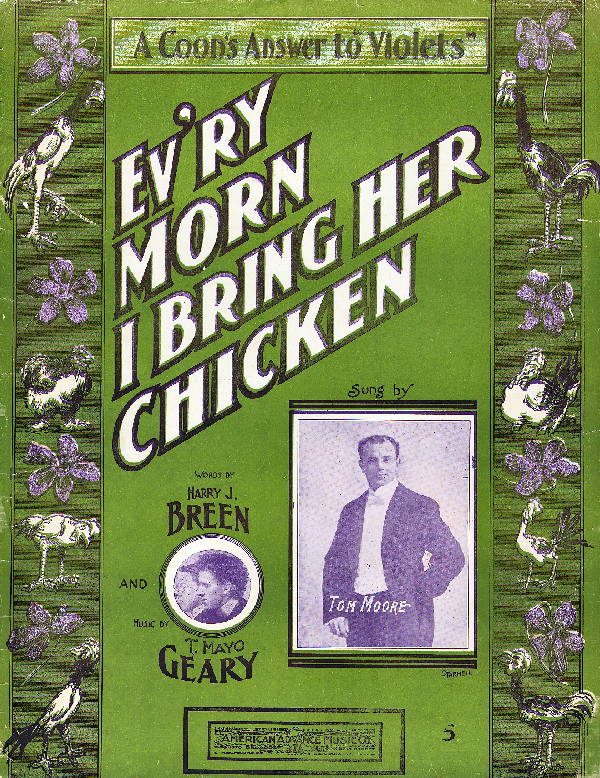 Ev'ry Morn I Bring Her Chicken Ev'ry Morn I Bring Her Chicken
1903
Music by: T. Mayo Geary
Words by: Harry J. Breen
Cover art: Starmer
On reading the
lyrics to this song I was a bit hesitant about publishing it. However, in the spirit we have shown in the past to present all aspects of the music of the Tin Pan Alley era and our past treatment of the subject of what were popularly known as "coon songs," I could not resist both the title and music associated with this song. From an historical perspective it seems that we often judge events from the past through present day sentiment and morality condemning things that we find objectionable today. In my opinion, that kind of thinking is what leads to revisionist actions that eventually mask the facts of events and ultimately produces a distorted view of the past. As objectionable as songs of this type are today, we must remember that at the time they provided entertainment and were wildly popular. Of course our intelligence tells us that this is wrong in today's context but it is what it is and was. However, our position has been to not be revisionist and to show all aspects of America's popular song despite their moral acceptance today. For more on the issue of "coon songs" please read our special article about this genre of song.
This song has a really nice melody and if you can get past today's judgment of them, the lyrics tell a rather amusing story of a man who is all about pleasing his woman through good food. The song is subtitled to be a response to another song titled "Violets" which tells of sending a loved one three violets each day which were "culled at daybreak." In this case, the protagonist culls his lady love a chicken every day which he has culled in his own illegal way. It is a cute response to the Violets but we all know it is steeped in today's unacceptable stereotypes.
Though I have found other songs credited to this song writing pair, I've found no biographical information for Harry J. Breen, (possibly b. 1886) or his partner in this song, T. Mayo Geary.
Hear and see the score
to this song (  Scorch format, be patient for images to load) Scorch format, be patient for images to load)
Listen to MIDI version
Lyrics
|
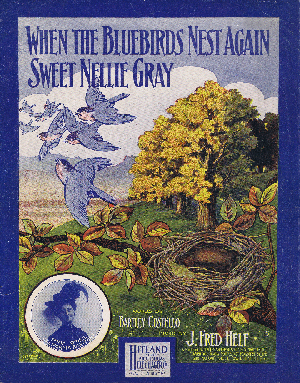 When the Bluebirds Nest Again, Nellie Gray When the Bluebirds Nest Again, Nellie Gray
1907
Music by: J. Fred Helf
Words by: Bartley Costello
Cover art: Starmer
Birds were always a great subject for songs during this period (and for many decades after) and the metaphor of a home to a nest has been one that few composers and lyricists could resist. We explored songs about birds in our April 2006 feature titled "Birds of a Feather."
Not knowing for sure who the first real Nellie Gray may have been that a song was written for, the seminal song so it seems for many songs that followed using Nellie as a subject was an 1854 ballad simply titled Nellie Gray by T. H. Howe and then soon after the 1856 ballad, Darling Nellie Gray (Scorch)
appeared and reached a higher level of popularity. This song was featured in our June 2009 article featuring a fabulous collection of 19th century songs donated to us that year.
It seems that Nellie caught on and there were many others including a Quadrille and the present song. Of course, by 1907, popular song in America had changed style significantly and this song is much more sophisticated in its scoring and harmony. The earlier songs were written in a period when many homes had pianos but the level of sophistication of t he songs were at a simpler level. Presumably, the skill levels of home performers was perceived as being at a more beginning level. As pianos became even more predominant in homes, so too did the performing skills allowing composers to show more complexity in the music. That's my theory at least. This ballad is sweet and melodic, much like many of the romantic songs of the period.
J. Fred Helf was a popular composer during the
first two decades of the twentieth century who, like many other successful composers,
formed his own publishing company. His company did quite well for several years
and published for a number of popular songwriters as well as for his own works.
Helf's firm's demise shows the fragility of many of the businesses of that period.
In 1910 Helf published Play That Barbershop Chord, by Lewis Muir and
William Tracey, or at least that is how Helf published it. Songwriter Ballard
Macdonald had begun work on the song and had written dummy lyrics before leaving
the song behind. The piece was finished by Lewis Muir and William Tracey, and
Macdonald was incensed that Helf left his name off the sheet music. He sued
Helf successfully, and the award of $37,500 forced Helf into bankruptcy thus
ending his foray into publishing.
Helf also wrote Every Race Has a Flag but the Coon (1900, with Will Heelan); Texas Tommy's Dance (1911); The Fatal Rose of Red (1900) and perhaps
his greatest title, If Money Talks, It Ain't On Speaking Terms With Me (
1902).
Listen to and view this song ( Printable using the Scorch plug-in, be patient, sometimes a long load time due to graphics) Printable using the Scorch plug-in, be patient, sometimes a long load time due to graphics)
Listen to MIDI version
Lyrics
|
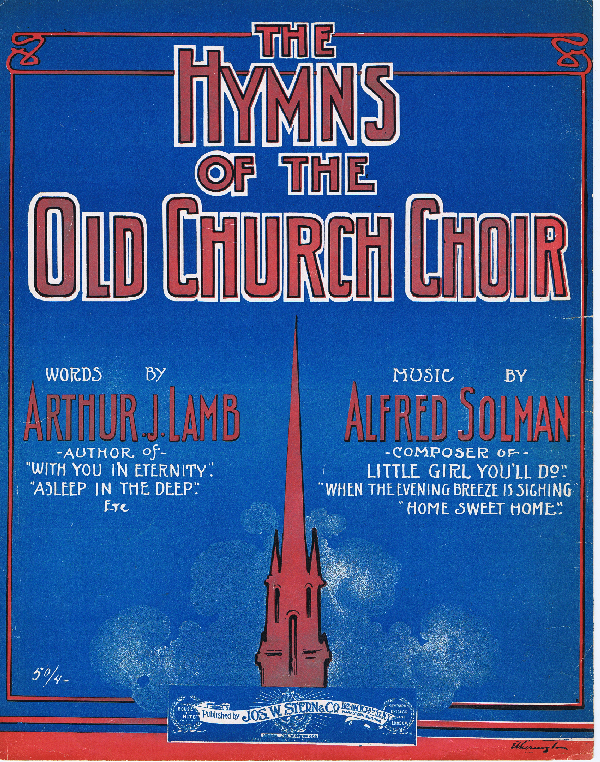 The Hymns of the Old Church Choir The Hymns of the Old Church Choir
1907
Music by: Alfred Solman
Words by: Arthur J. Lamb
Cover art: Etheridge
During the early years of our country's development, religion and God were unashamedly included in much of our music. In those less politically correct times, people were much more openly religious and music reflected society in that regard. Unlike today, people tolerated other's beliefs and rather than trying to quiet them, actually enjoyed the music and diversity that freedom in the United States held for them. We've also looked at this aspect of popular music in our April, 2003 article Sunday in the Parlor where we featured a number of well known and lesser known works that were popular during the prior century.
Many of the religious slanted songs of the period borrowed heavily from the liturgical music of the times and featured or were crafted around a popular hymn of the period. In this case, the composer has written a song that speaks of the old songs sung in church and includes the melodies and titles of several of the well known hymns of the day. After the verse, in the chorus we hear bits of, Nearer My God to Thee, Hosanna in the Highest, Holy, Holy, Holy and Rock of Ages. Overall, aside from the musical quotes, the song has a stately and hymnal quality about it in the verse as well. It is musically very moving and beautiful to my ears.
Alfred Solman (1868 - 1937) Was one of Tin Pan
Alley's more prolific lyricists who collaborated with a number of composers.
In spite of his output, little biographical information is available for him.
His most successful work is probably his 1916 song, There's a Quaker Down
in Quaker Town. Other works from his pen include; The Bird On Nellie's
Hat, 1906; Why Did You Make Me Care, 1912; In the Sweet Long Ago,
1916; The Heart You Lost in Maryland, You'll Find in Tennessee, 1907; My Lonely Lola Lo (In Hawaii), 1916, Clean
Hands and Tainted Gold (Scorch format) (1906) and In the Valley of the
Moon, 1913.

Arthur
J. Lamb (b. 1870, Somerset, England - d. 1928, Providence,
R.I.) is perhaps most well known as the lyricist for the famous and still popular, Asleep In The Deep (for a German version, see Des
Seemanns Los in our feature about music of the sea). This song though,
was his best selling hit song at the time. As with many songwriters, Lamb followed
up the success of "Asleep" with At The Bottom Of The Deep Blue
Sea in 1899 and another sea themed song, Out
Where The Billows Roll High (Scorch format) in 1901, both with music
by W.H. Petrie. Other popular songs by Lamb include Dreaming Of Mother And
Home, 1898, When The Bell In The Lighthouse Rings Ding, Dong,
1905, The Bird On Nellie's Hat, 1905, You
Splash Me and I'll Splash You, 1907 and the 1917 War song, Good
Luck To The USA.
Listen to and view one of my old favorites ( Printable using the Scorch plug-in, be patient, sometimes a long load time due to graphics) Printable using the Scorch plug-in, be patient, sometimes a long load time due to graphics)
Listen to MIDI version
Lyrics
|
Listen to this wonderful old song (Scorch format, be patient, long load time due to graphics)
Listen to MIDI version
Lyrics
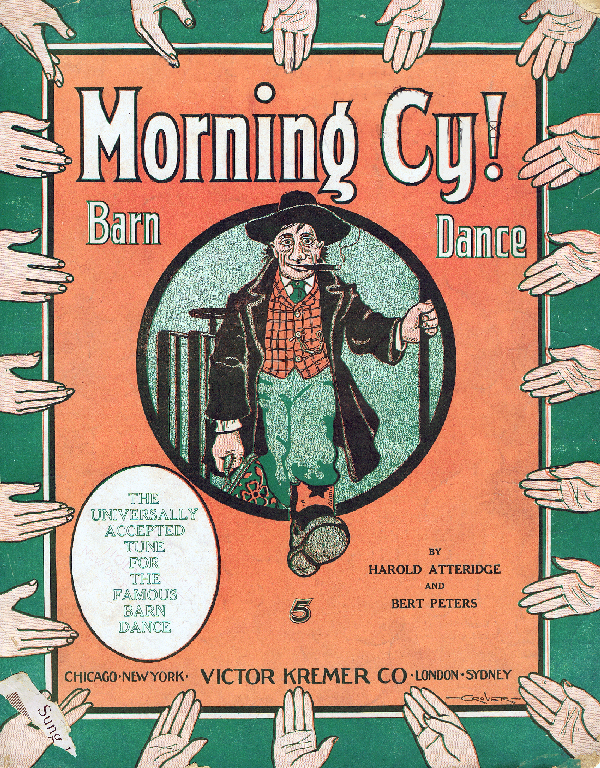 Morning Cy! Morning Cy!
1908
Music by: Bert Peters
Words by: Harold Atteridge
Cover art: Grover
The Barn Dance is most often associated in more modern times with the square dance and the WLS radio station in Chicago's program of the same name. However, the Barn Dance has its origins well before WLS and even the concept of radio. According to Sonny Watson's Streetswing.com web site, "The Barn Dance was originated in Scotland in the 1860's. The barn dance was also known as the "Pas de Quartre" which basically was a generic term for American folk dancing in rural communities or the "poor people's ballroom" of the times. It has been said to have first reared its head at the Gaiety Theater when Meyer Lutz composed the tune "Pas de Quatre." These parties were usually thrown after the raising of a barn or would be given as a birthday party, homecoming, or wedding etc. These dances were to merge with Square Dancing in the United States.
Barn dances were very popular up until about 1899 as farmers and common folk would usually not be invited to the fancier balls of the upper class. In the 1930's, Radio stations such as the WLS National Barn Dance Radio Show, broadcast many Country and Western songs as well as featuring many Country artists of the day which would add the main link to combine Country music, Barn dancing and Square dances together. Barn dances consisted of Waltzes, Virginia Reels, Corn Husking Dances, Jigs, Buck, Schottische dancing etc. Henry Ford the Automaker was very fond of these and Square dances."
Interestingly, there must have been some conflict and counter claims as to who originated the Barn Dance and its lyrics for this piece boldly states on the cover "The Universally Accepted tune for the famous Barn Dance." That implies that there was one and only Barn Dance while most histories of the Barn Dance indicate that it was a style or gathering, not one tune that defined the Barn Dance. I guess at some point when the "Barn Dance," became popular there emerged some competition to claim originality. This version of the tune includes lyrics that I'm sure were not originally included but were written by Mr. Atteridge. The style of the song definitely reflects popular European dances, especially the Schottische as mentioned above. Well, despite questionable origins, this tune is pleasant and does make you want to tap your toes.
(Richard) Harold Atteridge ( 1886 - 1938) was educated at the University of Chicago, earning a Bachelor of Philosophy. He became a staff writer for the Schuberts (producers of many Broadway musicals) and as such was the librettist for many Broadway Shows including many starring Al Jolson. The Internet Broadway Database lists nearly 70 shows for which Atteridge wrote the libretto or lyrics for individual songs. He was one of the most prolific lyricists of his day. Among his individual song credits are By the Beautiful Sea (Scorch version) with Harry Carroll and Come Dance With Me with Louis A. Hirsch in 1911.
Listen to this early "Barn Dance" song (  Scorch plug-in, be patient, long load due to graphics) Scorch plug-in, be patient, long load due to graphics)
Listen to MIDI version
Lyrics
|
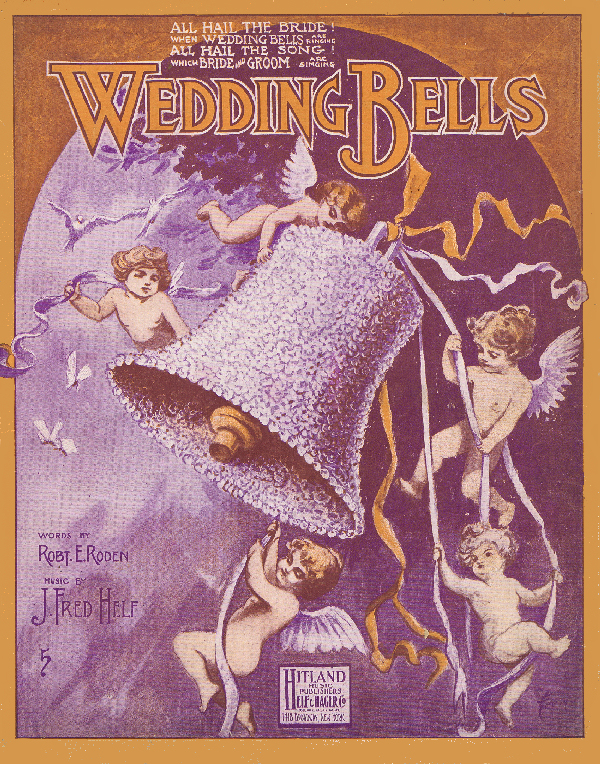 Wedding Bells Wedding Bells
1909
Music by: J. Fred Helf
Words by: Robert E. Roden
Cover art: un attributed
Yet another very common and popular style or subject for popular song during this era was that of the wedding. We've experienced happiness and sadness through this subject over the years and you'll find many songs related to weddings in our catalog of published songs. In June of 2004 we published an article titled Love and Marriage that features more songs about this ubiquitous subject.
The song is nice but in my opinion, somewhat pedestrian and unremarkable in the verse. When we arrive at the chorus the entire nature of the song changes to a very upbeat and happy tune that is much more invigorating and memorable. It's as though with the verse Helf was setting us up for a romantic ballad in dirge like fashion and then hits us side on with a lilting high speed chase to the finish. I don't care for the verse but the chorus is smashingly fun.
J. Fred Helf, see above.
Listen to this old "Wedding" song ( Printable using the Scorch plug-in) Printable using the Scorch plug-in)
Listen to MIDI version
Lyrics
|
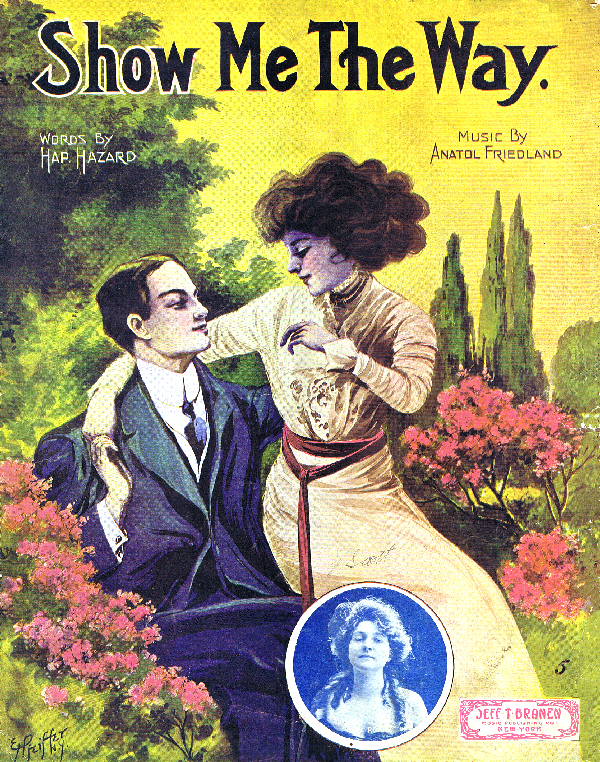 Show Me the Way Show Me the Way
1909
Music by: Anatol Freedland
Words by: Hap Hazard
Cover art: E. H. Pfeiffer
This beautiful cover by E. H. Pfeiffer is perhaps the best of the songs featured in t his article and certainly is exemplar of the exquisite illustration skills of Pfeiffer. We were fortunate several years ago to have been contacted by one of Pfeiffer's descendants who shared his biography with us and we wrote a special biographical article about Pfeiffer where you can see some of his other covers. Though some cover artists were more prolific, few were as artistic as Pfeiffer.
Though the composer Friedland is well known, the lyricist Hazard is obviously a pseudonym however I've been unable to retrieve from my memory or other resources who he actually was. It is possible that he was another incarnation of the publisher Brannen who used at least one other pseudonym, a backwards spelling of his name, Nenarb. Regardless, the music is sweet and very much reflective of the times and the innocent romanticism of those days. It also gives us a peek at the innuendo and sexual overtones that were now creeping into American song. The title, Show Me the Way is a young maiden's (only 16!) blushing reply to her beau's rather bold question "why can't we make love." Songs during this period often included double entendres and as Victorian morality began to melt away the boldness of lyrics in songs began to become more explicit. Of course, by today's standards, the exchange between these two is exceptionally chaste. The music is a somewhat plodding waltz that is nonetheless, sweet and melodically pleasant.
Anatol(e) Friedland (b. 1881, St. Petersburg,
Russia D. 1938, Atlantic City, NJ). A noted songwriter, Friedland studied music
at the Moscow conservatory and emigrated to the US sometime after 1900. In
the US he studied Architecture at Columbia University and later operated the
Club Anatole, a speakeasy on West 44th Street in Manhattan during the prohibition
years. Friedland spent many years as a vaudeville performer. In 1911, Friedland
wrote the score for a Broadway musical with lyricist Malvin Franklin called The
Wife Hunters. Based on the success of this show, the Shuberts hired Anatole
to write music for their Winter Garden productions, including The Passing
Show. In 1912, Anatole wrote the score for the Shubert hit Broadway
To Paris.
In 1913, he met L. Wolfe Gilbert; a fellow Russian and the team turned out
many successful songs. Sometimes they appeared together on stage singing their
own songs. Other times, Friedland appeared as just a 'singles' act, playing the
piano and singing. The long time collaboration with Gilbert resulted in many
hits; among them are My Sweet Adair 1915; Are You From Heaven 1917; My Own Iona (Moi-One-Ionae) 1916
(MIDI); Shades In The Night 1916; Singapore 1918; and Lily
of the Valley, A "Nut" Song, 1917. In 1936, Friedland lost one
leg through amputation and he retired , and took up residence at the Hotel Ritz-Carlton,
in Atlantic City, N. J.
Listen to and watch
the music play ( Scorch format, allow time for download) Scorch format, allow time for download)
Listen to MIDI version
Lyrics
|
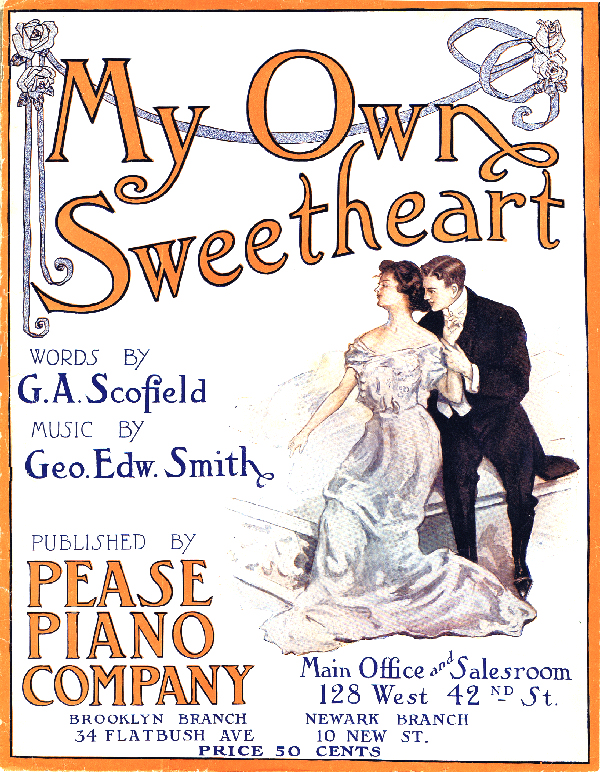 My Own Sweetheart My Own Sweetheart
1910
Music by: George Edward Smith
Words by: G. A. Scofield
Cover art: unknown
The Pease Piano Company was originally established in 1844 by Chauncey D. Pease as The C.D. Pease & Company in Cooperstown, NY. In 1874, the firm was renamed Pease & Company and had relocated to New York City. In 1888, Pease retired and the firm was taken over by his sons Harry and Samuel Pease. In the early 20th Century, Pease built a line of pianos under the “Wilbur” brand name. During the Great Depression era, Pease was purchased by the large Winter Piano Company. Winter produced the Pease brand name until about 1950. (from The Antique Piano Shop)
One forum discussion about Pease states; "Right across the street from Pease was another piano maker owned by William Carrotte. For a long time, Pease and Carrottes were very popular in the NY region. Eventually Mr. Pease's son married Mr. Carrotte's daughter, and they merged the company after their fathers retired. The young couple had lots of children, and to this day all the Pease and Carrottes get together once a year in Coopertown for a reunion." That information seems to conflict with the purchase of Pease by Winter and the Antique Piano shop's descriptions of both Pease and Winter but it makes for an amusing story about vegetables with "Pease and Carrotes."
This song is one of my favorites of the songs presented this month. The melody is wonderful and the scoring is at once both simple and complex. The harmony falls pleasantly on the ear and I can imagine this piece being played expertly by piano demonstrators at the Pease stores and wowing the potential customers. It is if anything a musical exemplar of the style at the time.
I am unable to find any biographical information on the songwriters, Smith & Scofield. It is quite possible they were on the staff at Pease and wrote the song for their proprietary use.
Listen to and watch
the music play (  Scorch version, be patient for graphics to load) Scorch version, be patient for graphics to load)
Listen to MIDI version
Lyrics
|
 Winter Winter
1910
Music by: Albert Gumble
Words by: Alfred Bryans
Cover art: Edgar Keller
The military march became one of the most popular genres of popular music during the 1890's and 1900's. From that model, many composers wrote what were called "march songs" where the march temp and style were incorporated into popular song styles of the times. This song is an outstanding example of this merge of seemingly opposing genres. Aside from being a celebration of the season (it is rather difficult for me to celebrate the cold weather we are experiencing this year) it is a downright fun song both musically and lyrically.
The cover is another of the best this month and the song is the second of my favorites this month. The song moves along at an exciting pace and one that conveys to me the need to move fast in the cold to stave off the chill. The melody is exciting and makes me smile. You have to love this song. Without further ado, I suggest you sit back, give it a listen and warm yourself up as you do so.
Albert Gumble (b. 1883 - d.1946) . Gumble not
only wrote original music but he also arranged for many of Tin Pan Alley's most
prominent composers including; Percy Wenrich, Alfred Bryan, Gus Kahn, Edward
Madden, Bud D. Sylva and Jack Yellen.He wrote the music for at least one Broadway
musical, Red Pepper in 1922 as well as a number of single hits during
the Tin Pan Alley days. Albert Gumble's best known single work work is Bolo
Rag (1908) however his credits also include Rebecca Of Sunnybrook Farm (1914), The Wedding of the Sunshine and the Rose (1915), If You'll
Come Back to my Garden of Love (1917), I'll Do it all over Again (1914) and The Chanticleer Rag.
Alfred Bryan (b. 1871, Ontario Canada - d. 1958,
New Jersey). A prolific and prominent lyricist of early Tin Pan Alley, Bryan
collaborated with some of the best composers including Percy Wenrich and Fred
Fisher. Bryan's most lasting hit was the classic, Peg
O' My Heart (MIDI) from 1913 with Fisher. Some of his other works include Rainbow (1908),and It's A Cute Little Way Of My Own sung in 1917 by the great Anna Held
in the show Follow Me.
Listen to and watch
the music play (  Scorch version, be patient for graphics to load) Scorch version, be patient for graphics to load)
Listen to MIDI version
Lyrics
|
This article published February 2011 and is Copyright © 2011 by Richard A. Reublin and The Parlor Songs Academy Text, images or
music may not be reproduced in part or in total without express written permission
of the author or an officer of the corporation. Though the songs published on
this site are often in the Public Domain, MIDI renditions are protected by copyright
as recorded performances.
Thanks for visiting us and be sure to come back again later to see our next issue or just to read some or all of our over 130 articles about America's music.
See our resources page for a complete bibliography of our own library resources used to research this
and other articles in our series.
If you'd like to contribute an article to us at Parlor Songs, we'd love to have
your help and contribution. The "rules"
for submissions can be found here, we'd love to have submissions by any of
our readers, anytime and would enjoy having a "reader submission" or
"favorites" feature from time to time. Heck, get involved, help us out
and write a feature for us!
|

![]()
![]()



 Harry
Von Tilzer
Harry
Von Tilzer Andrew
B. Sterling
Andrew
B. Sterling 








